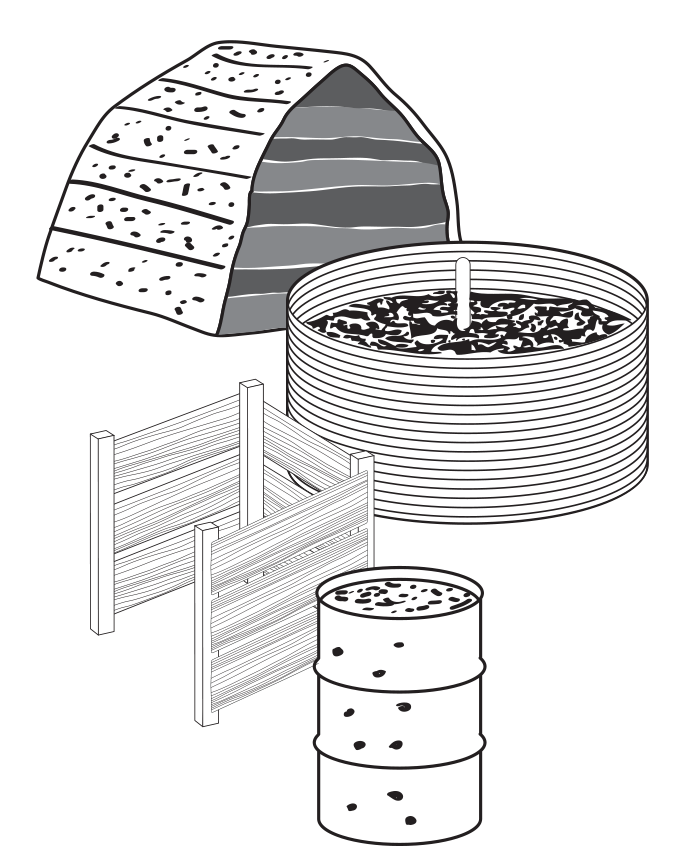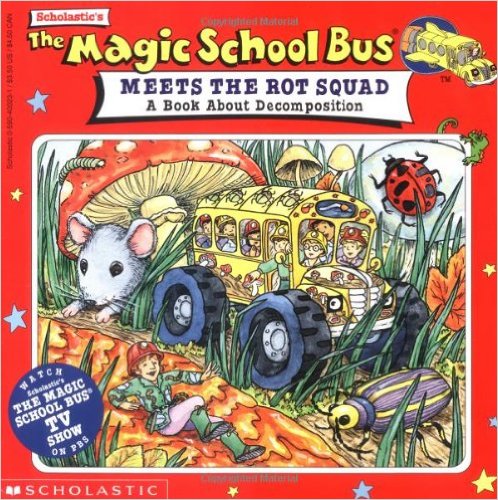The Rotten Truth
Students observe and explain the decomposition process and identify the methods and ingredients for making compost.
Background
Lesson Activities
Recommended Companion Resources
Credits
Author
Debra Spielmaker | Utah Agriculture in the Classroom
Standards
Texas Content Area Standards
-
ELA: 3.110.5.b.6
Comprehension skills: listening speaking, reading, writing and thinking using multiple texts. The student uses metacognitive skills to both develop and deepen comprehension of increasingly complex texts.
- ELA: 3.6.G: The student is expected to evaluate details read to determine key ideas.
-
ELA: 4.110.6.b.1
Developing and sustaining foundational language skills: listening, speaking, discussion, and thinking- oral language. The students develops oral language through listening, speaking, and discussion.
- ELA: 4.1.D: The student is expected to work collaboratively with other to develop a plan of shared responsibilities.
-
ELA: 4.110.6.b.6
Comprehension skills: listening, speaking, reading, writing and thinking using multiple texts. The student uses metacognitive skills to both develop and deepen comprehension of increasingly complex texts.
- ELA: 4.6.G: The student is expected to evaluate details read to determine key ideas.
-
ELA: 5.110.7.b.1
Developing and sustaining foundational language skills: listening, speaking, discussion, and thinking- oral language. The students develops oral language through listening, speaking, and discussion.
- ELA: 5.1.D: The student is expected to work collaboratively with others to develop a plan of shared responsibilities.
-
ELA: 5.110.7.b.6
Comprehension skills: listening, speaking, reading, writing, and thinking using multiple texts. The student uses metacognitive skills to both develop and deepen comprehension of increasingly complex texts.
- ELA: 5.6.G: The student is expected to evaluate details read to determine key ideas.
-
Science: 3.112.14.b.2
Scientific investigation and reasoning. The student uses scientific practices during laboratory and outdoor investigations.
- Science: 3.112.14.b.2.A: The student is expected to plan and implement descriptive investigations, including asking and answering questions, making inferences, and selecting and using equipment or technology needed, to solve a specific problem in the natural world.
- Science: 3.112.14.b.2.B: The student is expected to collect and record data by observing and measuring using the metric system and recognize differences between observed and measured data.
- Science: 3.112.14.b.2.D: The student is expected to analyze and interpret patterns in data to construct reasonable explanations based on evidence from investigations.
-
Science: 3.112.14.b.7
Earth and space. The student knows that Earth consists of natural resources and its surface is constantly changing.
- Science: 3.112.14.b.7.A: The student is expected to explore and record how soils are formed by weathering of rock and the decomposition of plant and animal remains.
-
Science: 4.112.15.b.2
Scientific investigation and reasoning. The student uses scientific practices during laboratory and outdoor investigations.
- Science: 4.2.A: The student is expected to plan and implement descriptive investigations, including asking well defined questions, making inferences, and selecting and using appropriate equipment or technology to answer his/her questions.
- Science: 4.2.B: The student is expected to collect and record data by observing and measuring, using the metric system, and using descriptive words.
- Science: 4.2.D: The student is expected to analyze data and interpret patterns to construct reasonable explanations from data that can be observed and measured.
-
Science: 5.112.16.b.2
Scientific investigation and reasoning. The student uses scientific practices during laboratory and outdoor investigations.
- Science: 5.2.B: The student is expected to ask well defined questions, formulate testable hypotheses, and select and use appropriate equipment and technology.
- Science: 5.2.C: The student is expected to collect and record information using detailed observations and accurate measuring.
- Science: 5.2.D: The student is expected to analyze and interpret information to construct reasonable explanations from direct (observable) and indirect (inferred) evidence.
-
Social Studies: 3.113.14.c.15
Social studies skills. The student communicates in written, oral, and visual forms. The student is expected to:
- Social Studies: 3.113.14.c.15.D: express ideas orally based on knowledge and experiences
-
Social Studies: 4.113.15.c.21
Social studies skills. The student communicates in written, oral, and visual forms. The student is expected to:
- Social Studies: 4.113.15.c.21.C: express ideas orally based on research and experiences
-
Social Studies: 5.113.16.c.25
Social studies skills. The student communicates in written, oral, and visual forms. The student is expected to:
- Social Studies: 5.113.16.c.25.C: express ideas orally based on research and experiences
-
Science: 3.112.5.b.1
Scientific and engineering practices. The student asks questions, identifies problems, and plans and safely conducts classroom, laboratory, and field investigations to answer questions, explain phenomena, or design solutions using appropriate tools and models. The student is expected to:
- Science: 3.112.5.b.1.B: use scientific practices to plan and conduct descriptive investigations and use engineering practices to design solutions to problems
- Science: 3.112.5.b.1.E: collect observations and measurements as evidence
-
Science: 3.112.5.b.2
Scientific and engineering practices. The student analyzes and interprets data to derive meaning, identify features and patterns, and discover relationships or correlations to develop evidence-based arguments or evaluate designs. The student is expected to:
- Science: 3.112.5.b.2.B: analyze data by identifying any significant features, patterns, or sources of error
-
Science: 3.112.5.b.10
Earth and space. The student knows that there are recognizable processes that change Earth over time. The student is expected to:
- Science: 3.112.5.b.10.B: investigate and explain how soils such as sand and clay are formed by weathering of rock and by decomposition of plant and animal remains
-
Science: 4.112.6.b.1
Scientific and engineering practices. The student asks questions, identifies problems, and plans and safely conducts classroom, laboratory, and field investigations to answer questions, explain phenomena, or design solutions using appropriate tools and models. The student is expected to:
- Science: 4.112.6.b.1.B: use scientific practices to plan and conduct descriptive investigations and use engineering practices to design solutions to problems
- Science: 4.112.6.b.1.E: collect observations and measurements as evidence
-
Science: 4.112.6.b.2
Scientific and engineering practices. The student analyzes and interprets data to derive meaning, identify features and patterns, and discover relationships or correlations to develop evidence-based arguments or evaluate designs. The student is expected to:
- Science: 4.112.6.b.2.B: analyze data by identifying any significant features, patterns, or sources of error
-
Science: 5.112.7.b.1
Scientific and engineering practices. The student asks questions, identifies problems, and plans and safely conducts classroom, laboratory, and field investigations to answer questions, explain phenomena, or design solutions using appropriate tools and models. The student is expected to:
- Science: 5.112.7.b.1.A: ask questions and define problems based on observations or information from text, phenomena, models, or investigations
- Science: 5.112.7.b.1.E: collect observations and measurements as evidence
-
Science: 5.112.7.b.2
Scientific and engineering practices. The student analyzes and interprets data to derive meaning, identify features and patterns, and discover relationships or correlations to develop evidence-based arguments or evaluate designs. The student is expected to:
- Science: 5.112.7.b.2.B: analyze data by identifying any significant features, patterns, or sources of error
-
Technology Applications: 126.8.c.1
Computational thinking--foundations. The student explores the core concepts of computational thinking, a set of problem-solving processes that involve decomposition, pattern recognition, abstraction, and algorithms. The student is expected to:
- Technology Applications: 126.8.c.1.A: decompose story problems into smaller, manageable subproblems and identify a solution to the problems
- Technology Applications: 126.8.c.1.C: develop a plan collaboratively and document a plan that outlines specific steps taken to complete a project
-
Technology Applications: 126.9.c.1
Computational thinking--foundations. The student explores the core concepts of computational thinking, a set of problem-solving processes that involve decomposition, pattern recognition, abstraction, and algorithms. The student is expected to:
- Technology Applications: 126.9.c.1.A: decompose story problems into smaller, manageable subproblems and discuss and document various solutions to the problems
- Technology Applications: 126.9.c.1.C: communicate design plans and solutions using a variety of options
-
Technology Applications: 126.10.c.1
Computational thinking--foundations. The student explores the core concepts of computational thinking, a set of problem-solving processes that involve decomposition, pattern recognition, abstraction, and algorithms. The student is expected to:
- Technology Applications: 126.10.c.1.A: decompose a real-world problem into smaller, manageable subproblems using graphic organizers such as learning maps, concept maps, or other representations of data
 Many types of containers are suitable for making compost—they just need to be accessible, resist decay, and allow air flow. How do you decide which container will work best? Consider the amount of time and space you have, and the quantity of materials you will be composting. Most compost containers fall into one of these categories: heaps (simple, stacked piles), hoops (caged enclosures), bins (boxed enclosures), and barrels (drum enclosures). For fast, hot compost, the ideal pile size is 1 cubic yard (3' x 3' x 3'). This volume effectively retains the heat generated by the bacteria. The volume of a single pile should not exceed 2 cubic yards in order to maintain proper ventilation of the pile. If space is a limiting factor, the pile sides can be insulated to maintain high temperatures in a smaller volume. Compost temperatures of 135–160°F speed decomposition and kill pathogenic organisms, flies, and weed seeds. In a well-built compost pile with proper ventilation and moisture, the activity of decomposers will provide this heat without any problem.
Many types of containers are suitable for making compost—they just need to be accessible, resist decay, and allow air flow. How do you decide which container will work best? Consider the amount of time and space you have, and the quantity of materials you will be composting. Most compost containers fall into one of these categories: heaps (simple, stacked piles), hoops (caged enclosures), bins (boxed enclosures), and barrels (drum enclosures). For fast, hot compost, the ideal pile size is 1 cubic yard (3' x 3' x 3'). This volume effectively retains the heat generated by the bacteria. The volume of a single pile should not exceed 2 cubic yards in order to maintain proper ventilation of the pile. If space is a limiting factor, the pile sides can be insulated to maintain high temperatures in a smaller volume. Compost temperatures of 135–160°F speed decomposition and kill pathogenic organisms, flies, and weed seeds. In a well-built compost pile with proper ventilation and moisture, the activity of decomposers will provide this heat without any problem. Introduce the vocabulary words to the students. Assess their prior knowledge by asking a series of questions such as:
Introduce the vocabulary words to the students. Assess their prior knowledge by asking a series of questions such as: